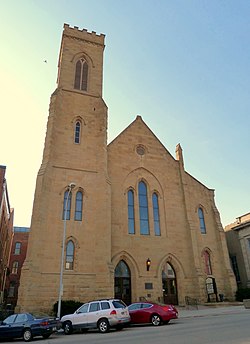
The United Church of Christ (UCC) is a mainline Protestant Christian denomination based in the United States, with historical and confessional roots in the Congregational, Calvinist, Lutheran, and Anabaptist traditions, and with approximately 4,852 churches and 802,356 members. The United Church of Christ is a historical continuation of the General Council of Congregational Christian churches founded under the influence of New England Pilgrims and Puritans. Moreover, it also subsumed the third largest Calvinist group in the country, the German Reformed. The Evangelical and Reformed Church and the General Council of the Congregational Christian Churches united in 1957 to form the UCC. These two denominations, which were themselves the result of earlier unions, had their roots in Congregational, Lutheran, Evangelical, and Reformed denominations. At the end of 2014, the UCC's 5,116 congregations claimed 979,239 members, primarily in the U.S. In 2015, Pew Research estimated that 0.4 percent, or 1 million adult adherents, of the U.S. population self-identify with the United Church of Christ.
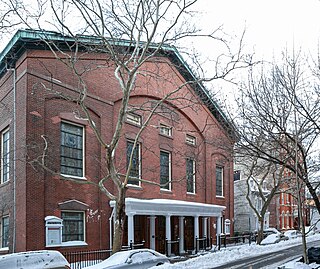
Plymouth Church is an historic church located at 57 Orange Street between Henry and Hicks Streets in the Brooklyn Heights neighborhood of Brooklyn, New York City; the Church House has the address 75 Hicks Street. The church was built in 1849–50 and was designed by Joseph C. Wells. Under the leadership of its first minister, Henry Ward Beecher, it became the foremost center of anti-slavery sentiment in the mid-19th century. It has been listed on the National Register of Historic Places since 1961, and has been a National Historic Landmark since 1966. It is part of the Brooklyn Heights Historic District, created by the New York City Landmarks Preservation Commission in 1965.
The Meadville Lombard Theological School is a Unitarian Universalist seminary in Chicago, Illinois.
The National Association of Congregational Christian Churches (NACCC) is an association of about 400 churches providing fellowship for and services to churches from the Congregational tradition. The Association maintains its national office in Oak Creek, Wisconsin, a suburb of Milwaukee. The body was founded in 1955 by former clergy and laypeople of the Congregational Christian Churches in response to that denomination's pending merger with the Evangelical and Reformed Church to form the United Church of Christ in 1957.

First Unitarian Church is a historic congregation of the Unitarian Universalist Association in Cincinnati, Ohio, United States. Founded in the early nineteenth century, it survived a series of division and reunifications in the nineteenth century. Among the people who have worshipped in its historic church building on the city's northern side are many members of the Taft family, including William Howard Taft, the President of the United States.
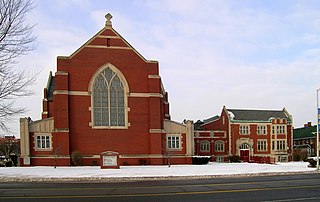
The St. John's Christian Methodist Episcopal Church is a church located in Detroit, Michigan. It was built as the North Woodward Congregational Church, listed on the National Register of Historic Places in 1982, and designated a Michigan State Historic Site in 1998.

Mokuaikaua Church, located on the "Big Island" of Hawaii, is the oldest Christian church in the Hawaiian Islands. The congregation dates to 1820 and the building was completed in 1837.

The Richmond Congregational Church is a historic church at 20 Church Street in Richmond, Vermont, United States. Built in 1903-04, it is a significant local example of Colonial Revival architecture, designed by prominent Vermont architect Walter R. B. Willcox. It was listed on the National Register of Historic Places in 2001. The congregation is affiliated with the United Church of Christ; the minister is Rev. Katelyn Macrae.
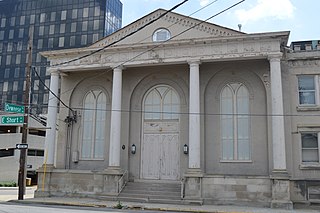
First African Baptist Church is a historic church at 264-272 E. Short Street in Lexington, Kentucky. The congregation was founded c. 1790 by Peter Durrett and his wife, slaves who came to Kentucky with their master, Rev. Joseph Craig, in 1781 with "The Travelling Church" of Baptists from Spotsylvania, Virginia.

St. Paul's United Methodist Church is located in downtown Cedar Rapids, Iowa, United States. The Louis Sullivan-designed building has been individually listed on the National Register of Historic Places since 1985. In 2000 it was included as a contributing property in the Second and Third Avenue Historic District.

Congregational United Church of Christ is located in the downtown area of Iowa City, Iowa, United States near the campus of the University of Iowa. The congregation was organized in 1856 and the church building was listed on the National Register of Historic Places in 1973. In 2004 it was included as a contributing property in the Jefferson Street Historic District.
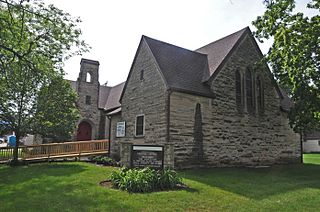
St. Luke's Methodist Church is a Late Gothic Revival church in Monticello, Iowa whose church building was completed in 1950. It is now the Monticello Heritage and Cultural Center. It is the only church in Iowa designed by nationally prominent architects Cram & Ferguson, who specialized in ecclesiastical architecture.

Denmark Congregational United Church of Christ is located in Denmark, Iowa, United States. The church building was listed on the National Register of Historic Places as Denmark Congregational Church in 1977. The church is noteworthy because of its association with the Rev. Asa Turner, Jr. He was a noted abolitionist and supporter of the temperance movement, who was the pastor of the congregation in its early years. He was an early Congregationalist missionary to Iowa and encouraged the American Home Missionary Society to send more missionaries to the Iowa Territory. His requests resulted in the arrival of nine young men from Andover Theological Seminary in 1843. Known as the "Iowa Band", they established churches in eastern Iowa based on Turner's Denmark church.
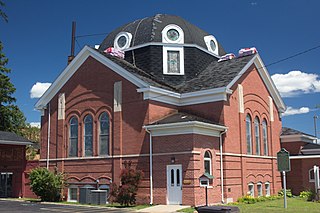
The Clare Congregational Church, also known as the Clare Congregational United Church of Christ, is a church located at 110 West Fifth Street in Clare, Michigan. It was designated a Michigan State Historic Site and listed on the National Register of Historic Places in 1994.

Swedish Evangelical Lutheran Church, now known as Swedesburg Evangelical Lutheran Church, is a historic church located in Swedesburg, Iowa, United States. The congregation was officially organized in 1866 by the Swedish Lutheran congregation from New Sweden in Jefferson County, Iowa. The present church was built in 1928 as the third church to stand on the same site. The first frame church, built in 1868, was destroyed in a fire in 1883. The second frame church, with a 110-foot (34 m) tower, was completed the same year. In 1927 it too was also destroyed by fire. The congregation hired Burlington, Iowa architect W.F. Weibley to design the present Late Gothic Revival church building. It is composed of tan brick with Bedford stone trim. The church was added to the National Register of Historic Places in 1999.

Welsh Congregational United Church of Christ, formerly known as First Welsh Congregational Church, is located in a rural area southwest of Iowa City, Iowa, United States. It was listed on the National Register of Historic Places in 1977.
40.7244°N 111.8146°W The First Congregational Church of Salt Lake City, Utah is a Congregational church affiliated with the National Association of Congregational Christian Churches. Established in 1865, it was the first church not a part of The Church of Jesus Christ of Latter-day Saints in Utah. The congregation started Utah's first free public schools.

Christ Episcopal Church, or simply Christ Church, is an historic church building located in Burlington, Iowa, United States. It is a part of the Episcopal Diocese of Iowa, and is a contributing property in the Heritage Hill Historic District listed on the National Register of Historic Places.

Built in 1816, the Unitarian Universalist Meeting House is the oldest remaining place of worship established by white settlers in Burlington, Vermont. It is located along the northern side of the intersection of Pearl Street and the Church Street Marketplace.

The Heritage Hill Historic District is a nationally recognized historic district located north of downtown Burlington, Iowa, United States. It was listed on the National Register of Historic Places in 1982. The area is primarily a residential neighborhood on the hill north of the central business district. Several churches act as a buffer and provide a transition from the residential area and the commercial areas in the valley. At the time of its nomination there were 141 structures in the district. The breakdown of their uses at that time included: 113 residences, 10 churches or religious use facilities, 7 public or government buildings, and 11 commercial structures. The district also includes North Hill Park, which has been in continuous use since the city was founded in 1836 and is one of the two oldest city parks in Burlington.
